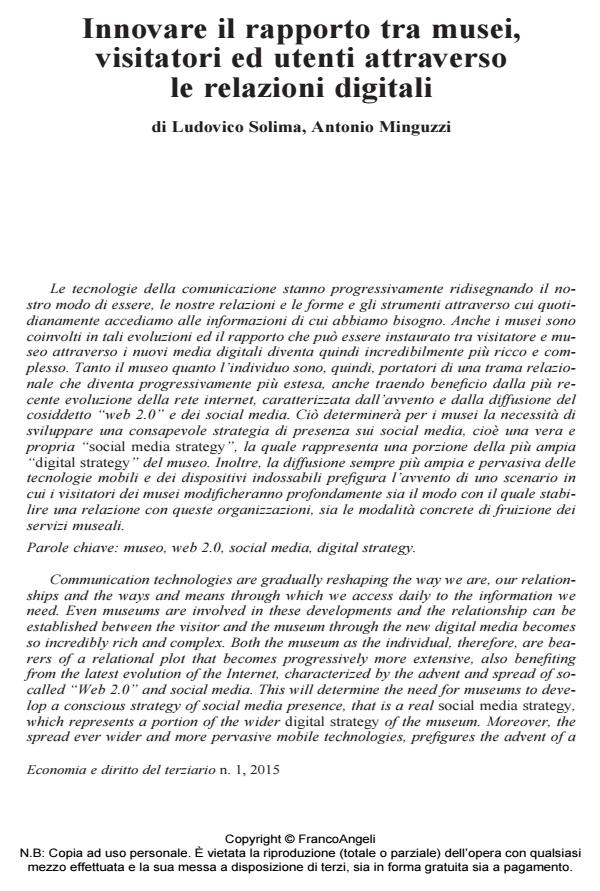Innovare il rapporto tra musei, visitatori ed utenti attraverso le relazioni digitali
Titolo Rivista ECONOMIA E DIRITTO DEL TERZIARIO
Autori/Curatori Ludovico Solima, Antonio Minguzzi
Anno di pubblicazione 2015 Fascicolo 2015/1
Lingua Italiano Numero pagine 21 P. 41-61 Dimensione file 71 KB
DOI 10.3280/ED2015-001003
Il DOI è il codice a barre della proprietà intellettuale: per saperne di più
clicca qui
Qui sotto puoi vedere in anteprima la prima pagina di questo articolo.
Se questo articolo ti interessa, lo puoi acquistare (e scaricare in formato pdf) seguendo le facili indicazioni per acquistare il download credit. Acquista Download Credits per scaricare questo Articolo in formato PDF

FrancoAngeli è membro della Publishers International Linking Association, Inc (PILA)associazione indipendente e non profit per facilitare (attraverso i servizi tecnologici implementati da CrossRef.org) l’accesso degli studiosi ai contenuti digitali nelle pubblicazioni professionali e scientifiche
Le tecnologie della comunicazione stanno progressivamente ridisegnando il nostro modo di essere, le nostre relazioni e le forme e gli strumenti attraverso cui quotidianamente accediamo alle informazioni di cui abbiamo bisogno. Anche i musei sono coinvolti in tali evoluzioni ed il rapporto che può essere instaurato tra visitatore e museo attraverso i nuovi media digitali diventa quindi incredibilmente più ricco e complesso. Tanto il museo quanto l’individuo sono, quindi, portatori di una trama relazionale che diventa progressivamente più estesa, anche traendo beneficio dalla più recente evoluzione della rete internet, caratterizzata dall’avvento e dalla diffusione del cosiddetto "web 2.0" e dei social media. Ciò determinerà per i musei la necessità di sviluppare una consapevole strategia di presenza sui social media, cioè una vera e propria "social media strategy", la quale rappresenta una porzione della più ampia "digital strategy" del museo. Inoltre, la diffusione sempre più ampia e pervasiva delle tecnologie mobili e dei dispositivi indossabili prefigura l’avvento di uno scenario in cui i visitatori dei musei modificheranno profondamente sia il modo con il quale stabilire una relazione con queste organizzazioni, sia le modalità concrete di fruizione dei servizi museali.
Parole chiave:Museo, web 2.0, social media, digital strategy
Jel codes:O35, M31, Z11.
- Handbook of Research on Examining Cultural Policies Through Digital Communication Paola De Bernardi, Monica Gilli, pp.161 (ISBN:9781522569985)
Ludovico Solima, Antonio Minguzzi, Innovare il rapporto tra musei, visitatori ed utenti attraverso le relazioni digitali in "ECONOMIA E DIRITTO DEL TERZIARIO " 1/2015, pp 41-61, DOI: 10.3280/ED2015-001003